I've implemented VGG16 from scratch on both Keras and Pytorch to make sure that the implementation is exactly the same. I'm training it on CIFAR10 and the results are too different.
Here's my implementation in keras:
(x_train,y_train),(x_test,y_test)=cifar10.load_data()
x_train = x_train / 255
x_test = x_test / 255
y_train=np_utils.to_categorical(y_train,10)
y_test=np_utils.to_categorical(y_test,10)
model = Sequential()
model.add(Conv2D(input_shape=(32,32,3),filters=64,kernel_size=(3,3),padding="same"))
model.add(ReLU())
model.add(Conv2D(filters=64,kernel_size=(3,3),padding="same"))
model.add(ReLU())
model.add(MaxPool2D(pool_size=(2,2),strides=(2,2)))
model.add(Conv2D(filters=128, kernel_size=(3,3), padding="same"))
model.add(ReLU())
model.add(Conv2D(filters=128, kernel_size=(3,3), padding="same"))
model.add(ReLU())
model.add(MaxPool2D(pool_size=(2,2),strides=(2,2)))
model.add(Conv2D(filters=256, kernel_size=(3,3), padding="same"))
model.add(ReLU())
model.add(Conv2D(filters=256, kernel_size=(3,3), padding="same"))
model.add(ReLU())
model.add(Conv2D(filters=256, kernel_size=(3,3), padding="same"))
model.add(ReLU())
model.add(MaxPool2D(pool_size=(2,2),strides=(2,2)))
model.add(Conv2D(filters=512, kernel_size=(3,3), padding="same"))
model.add(ReLU())
model.add(Conv2D(filters=512, kernel_size=(3,3), padding="same"))
model.add(ReLU())
model.add(Conv2D(filters=512, kernel_size=(3,3), padding="same"))
model.add(ReLU())
model.add(MaxPool2D(pool_size=(2,2),strides=(2,2)))
model.add(Conv2D(filters=512, kernel_size=(3,3), padding="same"))
model.add(ReLU())
model.add(Conv2D(filters=512, kernel_size=(3,3), padding="same"))
model.add(ReLU())
model.add(Conv2D(filters=512, kernel_size=(3,3), padding="same"))
model.add(MaxPool2D(pool_size=(2,2),strides=(2,2)))
model.add(Flatten())
model.add(Dense(units=4096,activation="relu"))
model.add(Dense(units=4096,activation="relu"))
model.add(Dense(units=10, activation="softmax"))
opt = Adam(lr=0.0001, epsilon=1e-06)
model.compile(optimizer=opt, loss=keras.losses.categorical_crossentropy, metrics=['accuracy'])
hist = model.fit(x_train, y_train,
epochs=50,
batch_size=100,
validation_data=(x_test, y_test)
)
And the same in pytorch:
num_epochs = 50
num_classes = 10
batch_size = 100
learning_rate = 0.0001
trans = transforms.ToTensor()
train_dataset = torchvision.datasets.CIFAR10(root="./dataset_pytorch", train=True, download=True, transform=trans)
test_dataset = torchvision.datasets.CIFAR10(root="./dataset_pytorch", train=False, download=True, transform=trans)
train_loader = DataLoader(dataset=train_dataset, batch_size=batch_size, shuffle=True)
test_loader = DataLoader(dataset=test_dataset, batch_size=batch_size, shuffle=False)
class ConvNet(nn.Module):
def __init__(self):
super(ConvNet, self).__init__()
self.layer1 = nn.Sequential(
nn.Conv2d(3, 64, kernel_size=3, stride=1, padding=1),
nn.ReLU(),
nn.Conv2d(64, 64, kernel_size=3, stride=1, padding=1),
nn.ReLU(),
nn.MaxPool2d(kernel_size=2, stride=2))
self.layer2 = nn.Sequential(
nn.Conv2d(64, 128, kernel_size=3, stride=1, padding=1),
nn.ReLU(),
nn.Conv2d(128, 128, kernel_size=3, stride=1, padding=1),
nn.ReLU(),
nn.MaxPool2d(kernel_size=2, stride=2))
self.layer3 = nn.Sequential(
nn.Conv2d(128, 256, kernel_size=3, stride=1, padding=1),
nn.ReLU(),
nn.Conv2d(256, 256, kernel_size=3, stride=1, padding=1),
nn.ReLU(),
nn.Conv2d(256, 256, kernel_size=3, stride=1, padding=1),
nn.ReLU(),
nn.MaxPool2d(kernel_size=2, stride=2))
self.layer4 = nn.Sequential(
nn.Conv2d(256, 512, kernel_size=3, stride=1, padding=1),
nn.ReLU(),
nn.Conv2d(512, 512, kernel_size=3, stride=1, padding=1),
nn.ReLU(),
nn.Conv2d(512, 512, kernel_size=3, stride=1, padding=1),
nn.ReLU(),
nn.MaxPool2d(kernel_size=2, stride=2))
self.layer5 = nn.Sequential(
nn.Conv2d(512, 512, kernel_size=3, stride=1, padding=1),
nn.ReLU(),
nn.Conv2d(512, 512, kernel_size=3, stride=1, padding=1),
nn.ReLU(),
nn.Conv2d(512, 512, kernel_size=3, stride=1, padding=1),
nn.ReLU(),
nn.MaxPool2d(kernel_size=2, stride=2))
self.fc1 = nn.Sequential(
nn.Linear(512, 4096),
nn.ReLU())
self.fc2 = nn.Sequential(
nn.Linear(4096, 4096),
nn.ReLU())
self.fcout = nn.Sequential(
nn.Linear(4096, 10),
nn.Softmax())
def forward(self, x):
out = self.layer1(x)
out = self.layer2(out)
out = self.layer3(out)
out = self.layer4(out)
out = self.layer5(out)
out = out.reshape(out.size(0), -1)
out = self.fc1(out)
out = self.fc2(out)
out = self.fcout(out)
return out
def weights_init(m):
if isinstance(m, nn.Conv2d) or isinstance(m, nn.Linear):
nn.init.xavier_uniform_(m.weight.data)
nn.init.zeros_(m.bias.data)
model = ConvNet()
model.apply(weights_init)
device = torch.device("cuda:0")#"cuda:0" if torch.cuda.is_available() else "cpu")
model.to(device)
# Loss and optimizer
criterion = nn.CrossEntropyLoss()
optimizer = torch.optim.Adam(model.parameters(), lr=learning_rate, eps=1e-6)
# Train the model
total_step = len(train_loader)
for epoch in range(num_epochs):
total = 0
correct = 0
for i, (images, labels) in enumerate(train_loader):
images = images.to(device)
labels = labels.to(device)
optimizer.zero_grad()
# Run the forward pass
outputs = model(images)
loss = criterion(outputs, labels)
# Backprop and perform Adam optimisation
loss.backward()
optimizer.step()
# Track the accuracy
total += labels.size(0)
_, predicted = torch.max(outputs.data, 1)
correct += (predicted == labels).sum().item()
print("Train")
print('Epoch [{}/{}], Accuracy: {:.2f}%'
.format(epoch + 1, num_epochs, (correct / total) * 100))
total_test = 0
correct_test = 0
for i, (images, labels) in enumerate(test_loader):
images = images.to(device)
labels = labels.to(device)
# Run the forward pass
outputs = model(images)
# Track the accuracy
total_test += labels.size(0)
_, predicted = torch.max(outputs.data, 1)
correct_test += (predicted == labels).sum().item()
print("Test")
print('Epoch [{}/{}], Accuracy: {:.2f}%'
.format(epoch + 1, num_epochs, (correct_test / total_test) * 100))
As you can see, I've adjusted it to use the same initializers in the network and parameters in the optimizer. However, the results are too different, as you can see in the following image.
Here's another execution of these same networks
And I've tried also adding some batch normalization after every layer (between layer and activation). It kind of solves the problem, but not completely. Here's the plot:
Is there any reasonable explanation to this behavior or have I made any mistake in the code?


